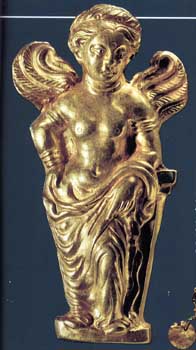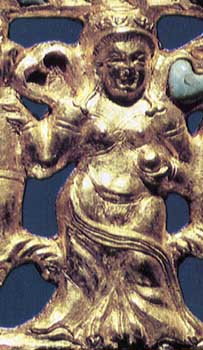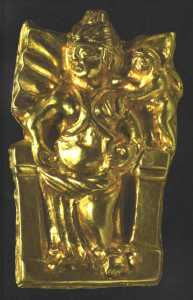
Mix-and match Aphrodite

Mix-and match Aphrodite
Texte venant avec la photo: Familiar yet exotic, the figure of the Greek goddess of love recalls the soft sensuousness Of Greco-Roman sculptures. But de wings-- never seen on Aphrodite in Greek or Roman art -- stem from ancient Bactrian tradition, and the forehead mark is imported from India. Bactrian art in the Dark Period was seldom pure; patrons of the local goldsmiths combined various traditions. This Aphrodite, in the form of a pendant, was found among hundreads of gold spangles lying on the bosom of the young woman in Grave Six.

Déesse Anahita
Texte venant avec la photo: On a temple pendant Anahita rules an entourage of fanciful creatures in her realm of sea, land and sky. her classical figure suggests Grecian influence; the beast evoke Scythian legends.
Photos tirées de la revue National Géographic, Vol. 177, no.3 march 1990 en page 57 - The Golden Hoard of Bactria
Ces deux figurines Bactria ont été trouver au nord the l'Afghanistan par une équipe Russe-Afghan en 1978. Ils ont trouvé 20, 000 artéfacts en or, le long du célèbre route de la soie. Ces les Grecques dans leur conquête de l'asie, ont décidé d'établir une colonie dans cette région stratégique de l'Asie vers 320 avant J-C.

Texte venant avec la photo : 5. Caste gold figurine of a winged Aphrodite in high relief with Cupid on column. Tillya-tepe necropolis, Bactria. Reflects the Graeco-Altaic style of the Kushan princes.
Photo prise sur le site Archaic Proto-Bactria and Early Ancient Bactria
INFORMATIONS
Petite histoire du pays Bactria
Autre
petite histoire du pays Bactria
Petit texte sur l'empire Greek
Autre description du Bactria
Un texte sur l'origine de la potrie Bactria
Information tirée du site Encyclopedia Mythica
La chronologie de l'histoire de l'Afghanistan
La carte de l'Afghanistan